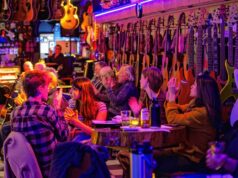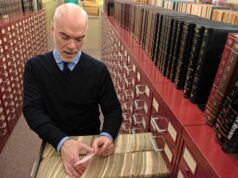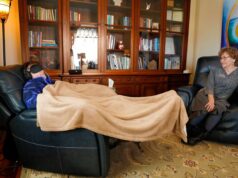

Seeds of Solidarity Farm is known by anyone who’s been there not only for vegetables and herbs, but for embracing art and being enveloped by a spiritual sense.
Rows of vegetables, surrounding trees, greenhouses and other places around the land are enhanced by portraits of inspiring figures such as Mahatma Gandhi, Thich Nhat Hanh, Wally and Juanita Nelson, Wendell Berry, Rachel Carson, and Angela Davis along with quotations from their teachings.
The deep connection between growing food and growing sensibility that farmers Ricky Baruc and Deb Habib embrace becomes clearer a few miles away through a new exhibit at the Augusta Savage Gallery.
Seeking Sacred on the Farm, featuring works by Baruc, Habib and their son, Levi Baruch, will be on exhibit at the University of Massachusetts-Amherst campus from Feb. 9 through March 10. There will be a Feb. 9 reception from 5 to 7 p.m. The exhibit includes Baruc’s woodwork — primarily meditation benches — as well as pottery and photographs by Habib and mandalas by Baruch.
An interactive mandala centerpiece, which visitors can embellish with objects, demonstrates that like their organic farm, this artistic display is a family affair.
Woven into the exhibit, in fact, along with photographs capturing views of the 30-acre farm, will be excerpts from a book the couple is writing, Making Love While Farming: A Field Guide to a Life of Passion and Purpose.
“It’s honoring the land, honoring those who inspire us who live this life and do this work,” says Habib, whose work is primarily for the nonprofit Seeds of Solidarity Foundation. With a mission “to awaken the power among youth, schools and families to grow food everywhere to transform hunger to health and create resilient lives and communities,” the foundation brings area teens together each summer as interns to learn about growing food, work in the community building greenhouses, raise bed gardens and teach people how to grow healthful produce themselves.
“Art becomes a way of being more attentive to these things and represent those relationships, those ways of being in the world in creative and ceremonial ways.”
Habib — whose role is in preparing and serving the food for the family, for SOL (Seeds of Leadership) Garden interns — contributes her pottery to the exhibit, which add meaning to the connection with food. She began working with clay as a child, and says, “I always felt that was the place I was drawn.”
Baruc’s pieces in the exhibit include meditation benches, altars, candle holders and chairs crafted from laurel and birch around the Orange farm and cedar from Montague. His woodwork, using native wood, features inlaid symbols of ground native corn and plants as an expression of his multi-dimensional spiritual practices.
Baruc dropped out of studying marine-biology in college when he had an epiphany — he didn’t know how to work with his hands — and turned his focus for the next 30 years to working as a carpenter, woodworker and farmer. “In the forest, I cut cedar trees by hand and then mill them into boards. In the fields, I grow ancient heirloom corn, wheat, sage and tobacco and use these to inlay sacred symbols on meditation benches, altars and furniture. I work with the natural curves that the forest creates to make furniture and art,” Baruc says.
His benches are designed with various sacred designs such as the Hundu “om” and the lotus along with the use of hot peppers, sage and ancient heirloom Naragansett, Massasoit, Hopi blue or Glass Gem corn kernals ground with tobacco, peppers and more. The merging of these elements combine the two worlds of farm and forest.
Baruc, who meditates regularly, just as Habib practices yoga, notes that the physical work of farming is in itself a form of meditation and creativity. He notes that while he didn’t grow up doing woodworking or other crafts, “it’s really important for my sanity. It balances things out. I love the ‘physicalness’ of farming, and I love the art process — creating in the head — so the mind has some creativity going on.”








